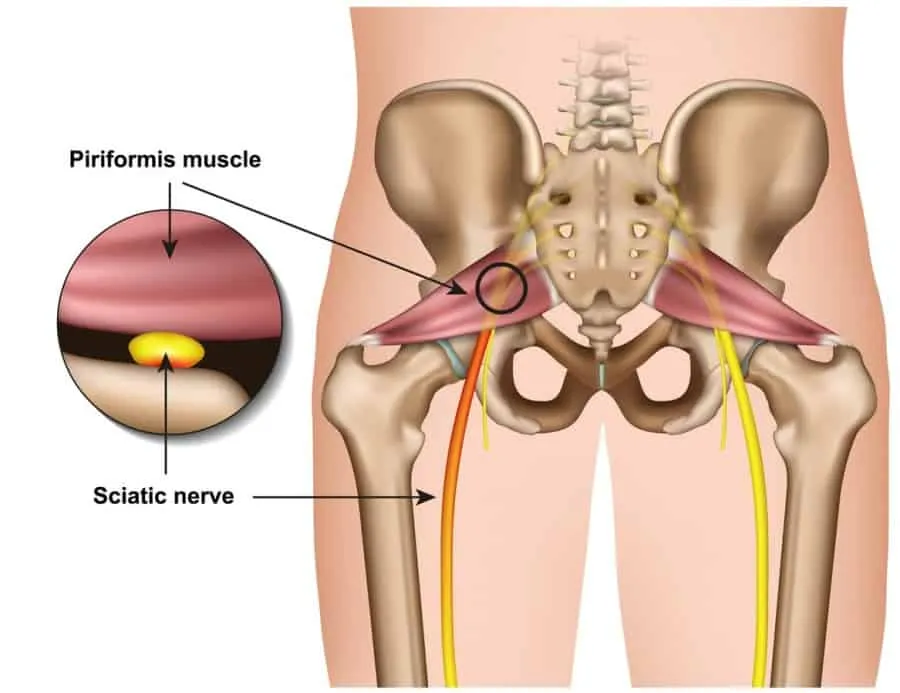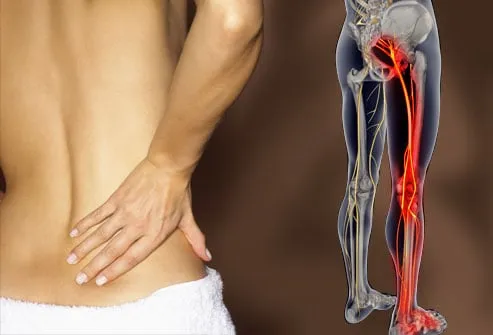What is Sciatica?
Sciatica is a condition characterized by crippling pain and paresthesia in the general region of the distribution of the Sciatic Nerve. The Sciatic pain is often mixed up with the normal back or hip pain that one may experience, however they are not the same. Sciatica is a unique pain that is only caused by a pathology of the Sciatic nerve. The sciatic nerve originates from the lower back (L4-S2) and travels down the back of the hip and all the way down the back of the leg.
What Causes Sciatica to Develop?

Herniated Disk: The most common cause of sciatica is the herniation of a disk in the lower region of our spine. The purpose of these disks is to provide cushioning to the vertebrae, which are the bone making up the spine. When one of these disks starts to herniate or bulge – either due to an accident or accumulation of stress over time- it may start to compress the Sciatic nerve.
There are a few different terms used to describe a disc herniation and severity of the pathology including: a bulging disc, disc protrusion, slipped disc, disc rupture, or herniated disc. A disc protrusion or bulging disc is the least severe pathology where someone may not experience any pain or symptoms. When a disc has “herniated” it indicates that the outer portion of the vertebral disc is torn, enabling the nucleus, or inner portion to herniate or extrude through the fibers. The herniated material can compress the nerves around the disc and create pain that can radiate through the back and sometimes down the and legs.
Lumbar Stenosis: Lumbar Stenosis, which is a form of Spinal Stenosis, is another condition that may cause the development of Sciatica. This is because this condition involves a narrowing of the spaces between the spine. This can occur centrally in the spinal canal, or for aminal stenosis indicating reduced space laterally where the nerves exit the spin, which could lead to compression of the Sciatic Nerve. Due to the nerve compression, Lumbar Stenosis presents itself with pain, tingling, and weakness of the lower back and legs. However, this may not always present with symptoms immediately, and may only be detected on an MRI or CT scan initially. Lumbar Stenosis commonly arises due to prior arthritis issues.
READ: Arthritis? Not to Worry

Piriformis Syndrome: Piriformis Syndrome involves the Piriformis muscle which is a small-sized muscle located deeply into the buttock region, starting by the sacrum and ending at the femur, or hip bone. The syndrome involves an intense spasm or tightening of this muscle, which may be caused by a number of reasons like prolonged sitting, or constant pressure to the buttock region. The spasms of this muscle may, in turn, lead to irritation of the Sciatic Nerve which is in close proximity to the muscle and cause intense pain of the Sciatica. The sciatic nerve can have slightly different orientation per individual and some individuals the sciatic nerve actually pierces right through the piriformis muscle.
Spondylolisthesis: Spondylolisthesis is an unstable condition involving a sudden shift of one of the bones of the spine, known as the vertebra, to shift out of their space and move onto the vertebra below them. When the vertebra from above, moves into the one below it, it may situate itself in a slightly forwards position, in turn, making the spinal canal smaller. This change in the size of the spinal canal may cause compression or irritation to the structures within it, including the Sciatic nerve, which may present itself with a number of painful symptoms. Spondolithisasis may be diagnosed by the doctor with the help of a simple X-ray after the required history and physical examination are done.
What is Sciatica Pain like?
The Sciatic Pain may often be confused with other back pains, however, since it is a highly specific pain, it can be easily distinguished from the others by these characteristics:
- Radiation From lower back to the legs
- Pain character can range from a mild ache to a sharp stab
- Associated with numbness of the legs and feet
- Rarely affects both sides of the body
- Pain can extend to the foot and toes
- Severe enough to keep people from performing their everyday activities
READ: The ONE Thing That Makes Sciatica Worse and What to do About it
Can Sciatica Cause Knee Pain?
A common question that is often asked regarding Sciatica pain, is if it involves the knees as well – and the answer is yes. The Sciatic nerve travels down the back of the leg tot the posterior portion of the knee. A person who is suffering from Sciatica may also experience pain or weakness in their knee(s) as well.
The Knee symptoms one may experience can be associated with:
- A sense of warmth in the front and back of the knees
- Acute weakness and an inability to carry the weight of the knees
- Inability to properly extend the knees
- Only one knee affected since Sciatica usually involves one side of the body
Can Sciatica Cause Hip Pain?
Since the Sciatic nerve also supplies the hip and thigh area, any compression or pathology to the nerve may also cause Hip pain. When one is suffering through intense pain that radiates one side of the body, you may be “off-loading” the weight of the body on the other side, and the change in posture and added stress can lead to hip and thigh pain that you may be experiencing along with Sciatic Pain.
How is Sciatica Diagnosed?
The diagnosis of Sciatica can be divided into two main steps:
History Taking: The history for Sciatica Diagnosis involves extensive questioning regarding the origin of the pain, whether the pain radiates to any body parts and if there are any sensory symptoms like numbness or tingling associated with it.
Physical Examination: The Physical examination for Sciatica Diagnosis involves a movement examination of the lower back, hip and leg; nerve sensory test; muscular strength test; alignment and postural assessment; and specific nerve test like the Lasegue’s Sign which is observed by the Straight Leg raising Test. (1)
What Causes Sciatica Flare-Up?
Although the main cause of development of Sciatica in the first place is when a herniated disk or a bone spur causes compression or damage to the Sciatic Nerve, there are numerous other reasons which may cause Sciatic Pain to flare up. These include:
High Heels:
When one wears high heels, they are essentially trying to balance themselves in order to stay upright. In doing this, the hamstring muscles are involved which leads to stretching and/ or irritation to the Sciatic Nerve. Wearing non-cushioned high heels, may also transfer constant forces of impact to the backbone and pelvic region creating increased pressure or tension around the Sciatic Nerve.
Emotional Anxiety:
Being under constant stress or in an anxious condition may also cause your Sciatic Pain to flare up. According to studies, constant emotional anxiety may cause the brain to reduce blood flow and thus reduced oxygenation, which can contribute to the symptoms of Sciatic Pain.
Keeping Keys/Wallet in Your Back Pocket:
Those who habitually keep hard objects like keys and wallets in their back pockets, and then sit on them for longer periods of time may find their Sciatica flaring up.These objects in our back pocket can press against the Piriform muscles in the back of the hip compressing the Sciatic Nerve which runs right under them. The obvious solution is to put your wallet in your front pocket or jacket or to use a money clip. It is advised that one should try to keep these objects in their front pocket, especially when expected to sit on them for a prolonged time.

Bending or Lifting Improperly:
Bending down to lift a weight – whether it is a flower pot or just a piece of gym equipment – may cause a sudden jerk or pressure to the lumbar disks, which can cause stress and compression to the Sciatic Nerve. We want to make sure we are using proper mechanics when we lift, don’t lift with your back, but instead lift with your legs. If an object is real heavy or awkward- then perform a “team lift” with the help of another person.
Skin Tight Clothes:
People who have had recurrent episodes of a Sciatica Flare up, often report that they wear tight tight clothing such as: a pair of jeans or underwear with an ill-fitting elastic band. The extra tension of these clothes especially while one sits or bends can cause the Sciatic Nerve to become compressed or pinched and cause their Sciatica to flare up.
READ: 3 More Things that Cause Sciatica And Back Pain That You Didn’t Know Until Now!
Who is at Greater Risk for Sciatica?
- Age: Studies have shown, those between the ages of 40 to 64 are at greater risk for Sciatica.
- Height: The taller a person is, the more likely they are to develop Sciatic Pains.
- Smoking: Smoker is at greater risk for Sciatica than non-smokers. (2)
- Stress and Anxiety: Those who suffer through constant stress are at high risk for Sciatica.
- Exercise: Exercise like lifting and bending, when done improperly- can put one at greater risk for Sciatica.
- Driving: The constant vibrations when driving for long periods of the day, can increase the chances of developing Sciatica, especially if sitting improperly. It’s important to make sure your seat is properly adjusted to your size and shape. Does your vehicle have an adjustable lumbar support? If not you can purchase a lumbar pillow to help maintain the proper curve of your low back when driving. Make sure you maintain proper position and alignment when you sit by maintaining a mild curve in the “small” of your back / lumbar region. You can also adjust the tilt of the seat back or sometimes even the incline of the seat rest as well. Make some small adjustments and look for positions of comfort. If in doubt- consult with a physical therapist.
Can Sciatica Be Cured?
Sciatica is most often relieved by conservative methods. It is rare that surgery is needed or necessary when addressed properly. If the sciatic nerve is really flared up- a brief period of rest (1-2 days) and even some over the counter medication to ease the pain and/ or inflammation can be helpful. But even in these early stages of recovery- movement is needed and necessary. Determining the best movement is going to be determined by what is causing your specific pain. If you’re unsure about this- then it’s best to have an examination and consult with your doctor or physical therapist.
How Long Does Sciatica Last?
Sciatica usually has a good prognosis and resolves within a period of 4 to 6 weeks, without any outstanding complications. However, in the cases that involve Sciatic nerve damage, or is caused by multiple recurrent episodes, it may be more prolonged and recurrent.
Bottom Line:
Sciatica and the intense pain associated with it can negatively affect one’s livelihood as the affected person is unable to carry out simple everyday activities. Finding the right therapeutic movement or exercise is key and it is recommended to consult with your physical therapist or doctor as soon as possible to get a quick and complete recovery from this condition.
For more tips on how to relieve your sciatic and lower back pain read:
Sciatica and Back Pain: When Do I Use Ice?.. And When Do I Use Heat?


References: 1. Koes BW, van Tulder MW, Peul WC. Diagnosis and treatment of sciatica. BMJ. 2007;334(7607):1313-1317. doi:10.1136/bmj.39223.428495.BE 2. Miranda H, Viikari-Juntura E, Martikainen R, Takala EP, Riihimäki H. Individual factors, occupational loading, and physical exercise as predictors of sciatic pain. Spine (Phila Pa 1976). 2002 May 15;27(10):1102-9. doi: 10.1097/00007632-200205150-00017. PMID: 12004179. 3. Govind J. Lumbar radicular pain. Aust Fam Physician. 2004 Jun;33(6):409-12. PMID: 15253601.



